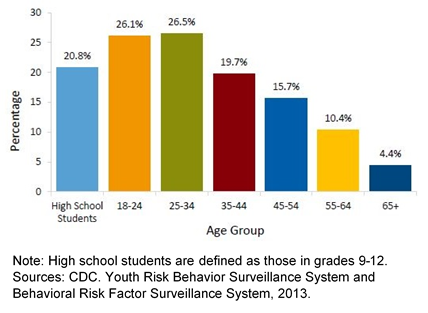Fact Sheets - Binge Drinking
Binge Drinking
Binge drinking is a serious but preventable public health problem.
Binge drinking is the most common, costly, and deadly pattern of excessive alcohol use in the United States.1,2,3 The National Institute on Alcohol Abuse and Alcoholism defines binge drinking as a pattern of drinking that brings a person’s blood alcohol concentration (BAC) to 0.08 grams percent or above. This typically happens when men consume 5 or more drinks or women consume 4 or more drinks in about 2 hours.4Most people who binge drink are not alcohol dependent.1
Who binge drinks?

- One in six US adults binge drinks about four times a month, consuming about eight drinks per binge.5
- Binge drinking is most common among younger adults aged 18–34 years, but is reported across the lifespan.5
- The prevalence of binge drinking among men is twice the prevalence among women.5
- Binge drinking is more common among people with household incomes of $75,000 or more than among people with lower incomes. However, people with lower incomes binge drink more often and consume more drinks when they do.5
- Over 90% of U.S. adults who drink excessively report binge drinking in the past 30 days.1
- Most people younger than age 21 who drink report binge drinking, usually on multiple occasions.6
Binge drinking has serious risks.
Binge drinking is associated with many health problems,7–9 including the following:
- Unintentional injuries such as car crashes, falls, burns, and alcohol poisoning.
- Violence including homicide, suicide, intimate partner violence, and sexual assault.
- Sexually transmitted diseases.
- Unintended pregnancy and poor pregnancy outcomes, including miscarriage and stillbirth.
- Fetal alcohol spectrum disorders.
- Sudden infant death syndrome.
- Chronic diseases such as high blood pressure, stroke, heart disease, and liver disease.
- Cancer of the breast, mouth, throat, esophagus, liver, and colon.
- Memory and learning problems.
- Alcohol dependence.
Binge drinking costs everyone.
- Drinking too much, including binge drinking, cost the United States $249 billion in 2010, or $2.05 a drink. These costs resulted from losses in workplace productivity, health care expenditures, criminal justice costs, and other expenses. Binge drinking was responsible for 77% of these costs, or $191 billion.2
Preventing binge drinking
The Community Preventive Services Task Force recommends evidence-based interventions to prevent binge drinking and related harms.10 Recommended strategies include:
- Using pricing strategies, including increasing alcohol taxes.
- Limiting the number of retail alcohol outlets that sell alcoholic beverages in a given area.
- Holding alcohol retailers responsible for the harms caused by illegal alcohol sales to minors or intoxicated patrons (dram shop liability).
- Restricting access to alcohol by maintaining limits on the days and hours of alcohol retail sales.
- Consistently enforcing laws against underage drinking and alcohol-impaired driving.
- Maintaining government controls on alcohol sales (avoiding privatization).
- Screening and counseling for alcohol misuse.
References:
- Esser MB, Hedden SL, Kanny D, Brewer RD, Gfroerer JC, Naimi TS. Prevalence of alcohol dependence among US adult drinkers, 2009–2011. Prev Chronic Dis. 2014;11:140329. doi: http://dx.doi.org/10.5888/pcd11.140329.
- Sacks JJ, Gonzales KR, Bouchery EE, Tomedi LE, Brewer RD. 2010 national and state costs of excessive alcohol consumption. Am J Prev Med. 2015;49(5):e73–e79.
- Stahre M, Roeber J, Kanny D, Brewer RD, Zhang X. Contribution of excessive alcohol consumption to deaths and years of potential life lost in the United States. Prev Chronic Dis 2014;11:130293. doi: http://dx.doi.org/10.5888/pcd11.130293.
- National Institute of Alcohol Abuse and Alcoholism. NIAAA council approves definition of binge drinking. NIAAA Newsletter. 2004;3:3.
- Kanny D, Liu Y, Brewer RD, Lu H. Binge drinking — United States, 2011. MMWR Suppl. 2013;62(suppl 3):77–80.
- US Department of Health and Human Services. Report to Congress on the Prevention and Reduction of Underage Drinking website. https://www.stopalcoholabuse.gov/resources/reporttocongress/rtc2016.aspx. Accessed May 26, 2017.
- World Health Organization. Global Status Report on Alcohol and Health—2014. Geneva, Switzerland: World Health Organization; 2014.
- Naimi TS, Lipscomb LE, Brewer RD, Colley BG. Binge drinking in the preconception period and the risk of unintended pregnancy: Implications for women and their children. 2003;11(5):1136–1141.
- Iyasu S, Randall LL, Welty TK, et al. Risk factors for sudden infant death syndrome among northern plains Indians. 2002;288(21):2717–2723.
- Community Preventive Services Task Force. The Guide to Community Preventive Services. Excessive Alcohol Consumption website. https://www.thecommunityguide.org/topic/excessive-alcohol-consumption. Accessed May 26, 2017.
- Page last reviewed: June 7, 2017
- Page last updated: June 7, 2017
- Content source:
- Maintained By:


 ShareCompartir
ShareCompartir